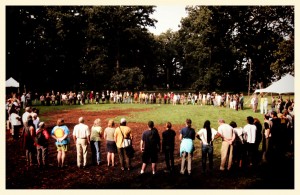Permaculture is about designing connections. This is because nature is a self-weaving web of relationships. It is the connective tissue that holds any community together. Our lives depend on the relationships we create. Like a hammock they hold us when we need it most and they enable the communication that we need to know and to be known. Imitating these patterns in nature is central to permaculture and should be central to our designs and design approach.
This is one of the most valuable outcomes of gatherings like the North American Permaculture Convergence. Seeing one another’s faces and hearing our voices connects us like nothing else. As Permaculture designers, it is the patterns of connections we see and design first. This allows us to understand the roles that the system needs played so that we can regenerate the lost connections. A swale or a tree may be simply missing links in the chain of life. This is true of any of the structures we design, physical or invisible. Unlike other designers, we design connections, not structures.
This is important to remember in our conversations about standards, diplomas, and recommendations. Listening to the founder or Air B and B I realized that though the web can favor whoever has the slickest and most optimized website, it can also allow a self-organizing network of participant reviews. Staying in people’s homes while traveling is a long established tradition that faded with the anonymity of growing cities. Trust turned from people to well-known corporations. To turn trust back to individuals requires a community creating reputations.
This is how sites like Air B and B and Angie’s list works. Users review providers, recommending some and warning against others. There is no policing from above. Like the Seed Saver’s or Craig’s List, the organizers simply act as connectors for self-determined exchanges. This is how a low-cost, self-organizing Permaculture web community could up-hold standards, make informed choices, and communicate. It may also be a self-supporting business rather than another not-for-profit run off of the sacrificial blood of true believers intent on making it work.
Structures are the design instrument of the last century. Even large corporations are focusing on owning the underlying patterns rather than stuff. Just think of GMOs and software giants. Imitating nature, permaculture has always focused on designing the lightweight living infrastructure that enables functional systems rather than over-built hard structures.
As East Indian educator Sugata Mitra has pointed out, Universities and most of our educational system and ideas about it are Victorian hangovers. They were meant to train and accredit replaceable parts for worldwide computers made from clerks capable of keeping records and enabling the functioning of empire. Computer networks have made most of this unnecessary. They also provide the connective tissue to allow for the self-organization of widespread communities. Permaculture has always been about designing such connective networks. The challenge is to remember that such sophisticated systems as our bodies and the biosphere required no central organization for their design, development, or growth. They are truly self-organized and maintained. Nodes in biological networks are formed when paths cross. Successful species like trout or spiders, recognize and place themselves at crossroads, where their needs will come to them. We would do well to learn from such good designers.
Share this post!







By submitting a comment you grant Pattern Mind by Joel Glanzberg a perpetual license to reproduce your words and name/web site in attribution. Inappropriate and irrelevant comments will be removed at an admin’s discretion. Your email is used for verification purposes only, it will never be shared.